In our blog, we will explain how elite marathon runners and race-walkers coped with the hot and humid ambient conditions during the 2019 World Athletic Championship. More details are available in two recent open-access manuscripts.[1,2]
Why is this study important?
Numerous international events are held in the summer, in hot and/or humid ambient conditions. While there is numerous studies on the effect of heat on recreational sportsman in a laboratory, there is paucity of data on how elite athletes competing at their physiological limits cope with those conditions. It is accepted that athletes may largely exceed the 2% dehydration threshold determined from laboratory study,[3] or may exceed the 40ºC core temperature[4] commonly use as both an ethical ceiling in research and a diagnostic criterion for heat stroke.[5] Despite those extreme responses, most athletes remain asymptomatic when competing in the heat.[6,7] Whilst heat-acclimation is considered an important countermeasure to protect the athlete,[8] we actually don’t know how elite athlete cope with the heat depending on their preparation and characteristics.
How did the study go about this?
Aspetar and World Athletics partnered to monitor the marathon and race-walk athletes during the Doha 2019 World Athletics Championships. 83 athletes completed a pre-race questionnaire on their acclimation, hydration and cooling strategies, along their previous history of heat illness or any recent health issues. We also analysed the medical record of the athletes admitted to the medical facility during the road-races (n=80) and measured the core temperature of 56 athletes and the skin temperatures in 107 athletes during the races. This was also the opportunity to pioneer some new technology to monitor skin temperature during competition.[9]
What did the study find?
Most endurance athletes had a strategy for drinking (93%, Figure 1), pre-cooling (80%) and mid-cooling (93%, Figure 2). Common pre-cooling techniques included ice vests and cold towels, and common mid-cooling included water dousing and cold-water ingestion; while menthol-based intervention are less common in athletes (<2%).
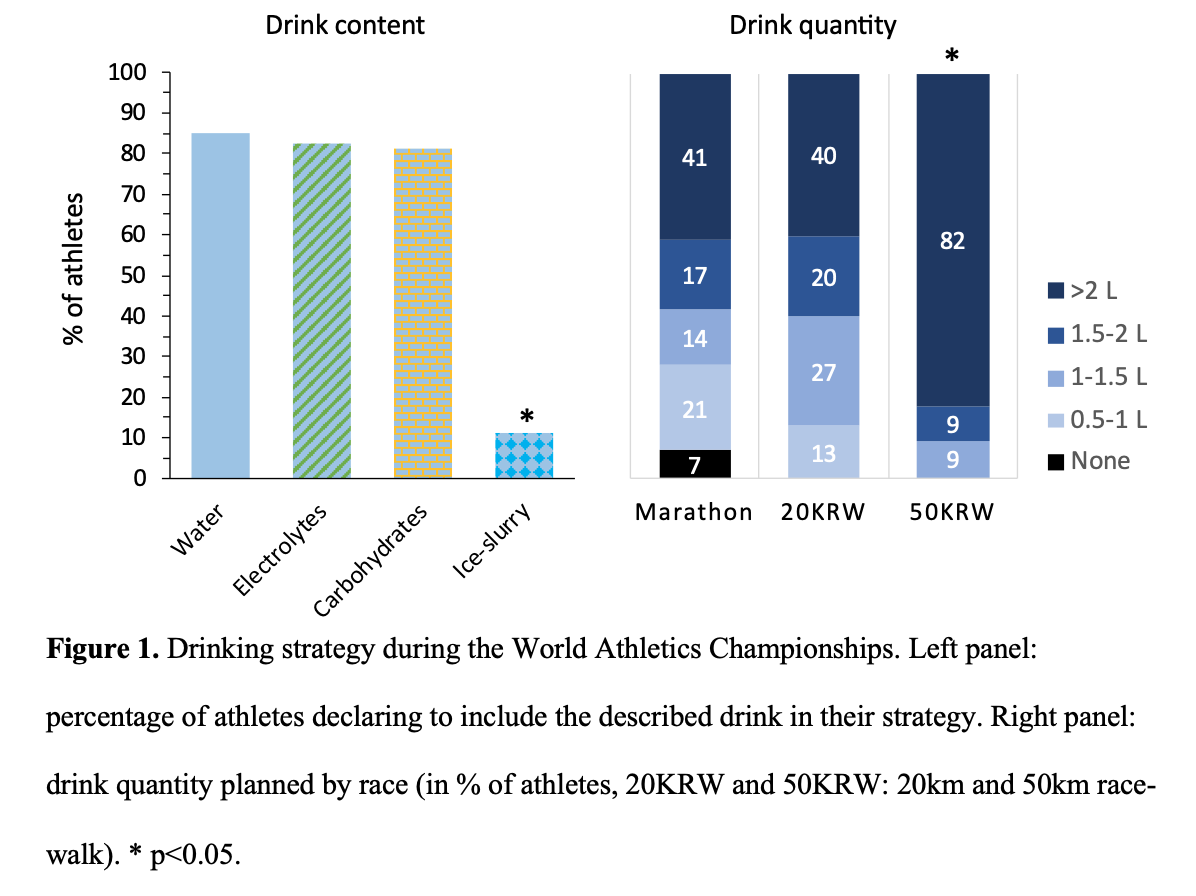
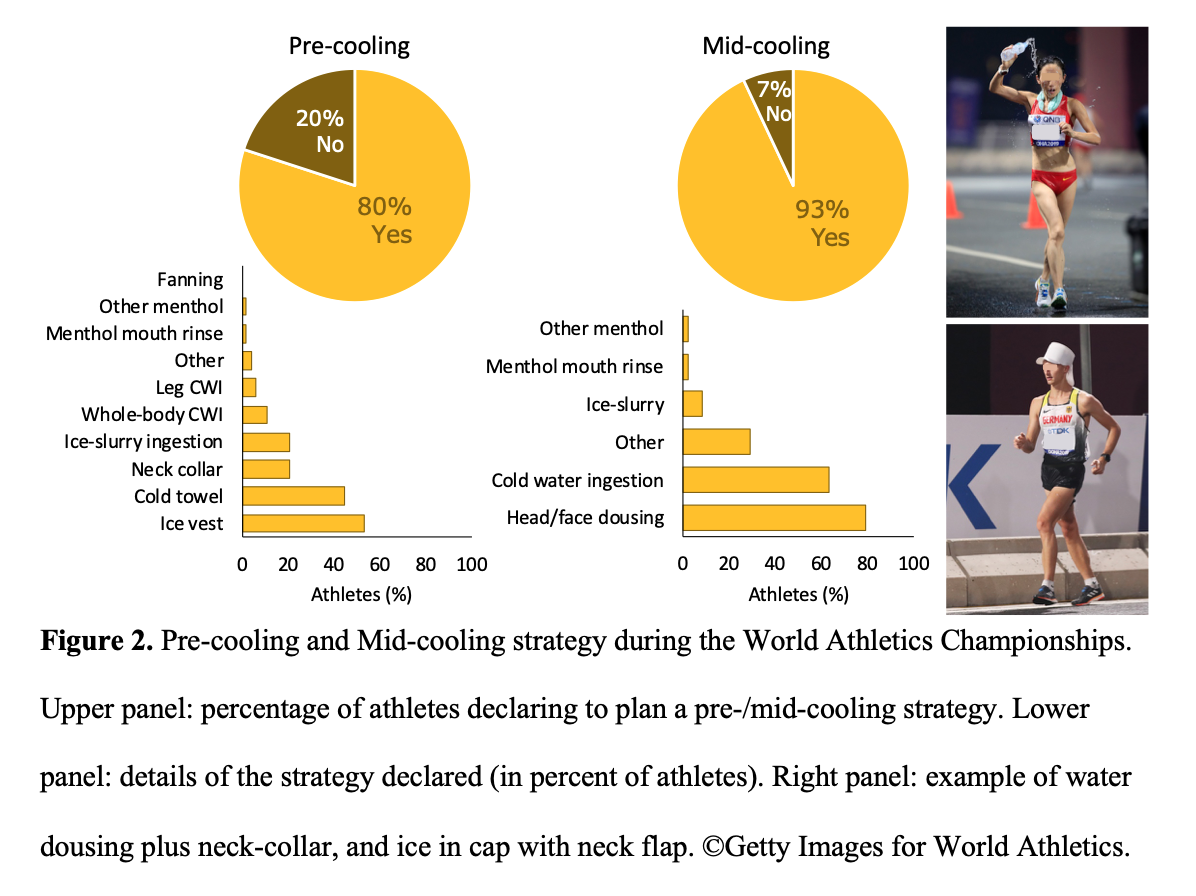
Relative body mass loss was higher in men than women (−2.8±1.5% vs −1.3±1.6%, Figure 3), but not associated with performance outcome (eg, race time, ‘did not finish’ (DNF) or placing). Athletes who used ice vests had a lower pre-race core temperature (37.5°C±0.4°C vs 37.8°C±0.3°C), but this did not translate neither into a statistical performance benefit in this study.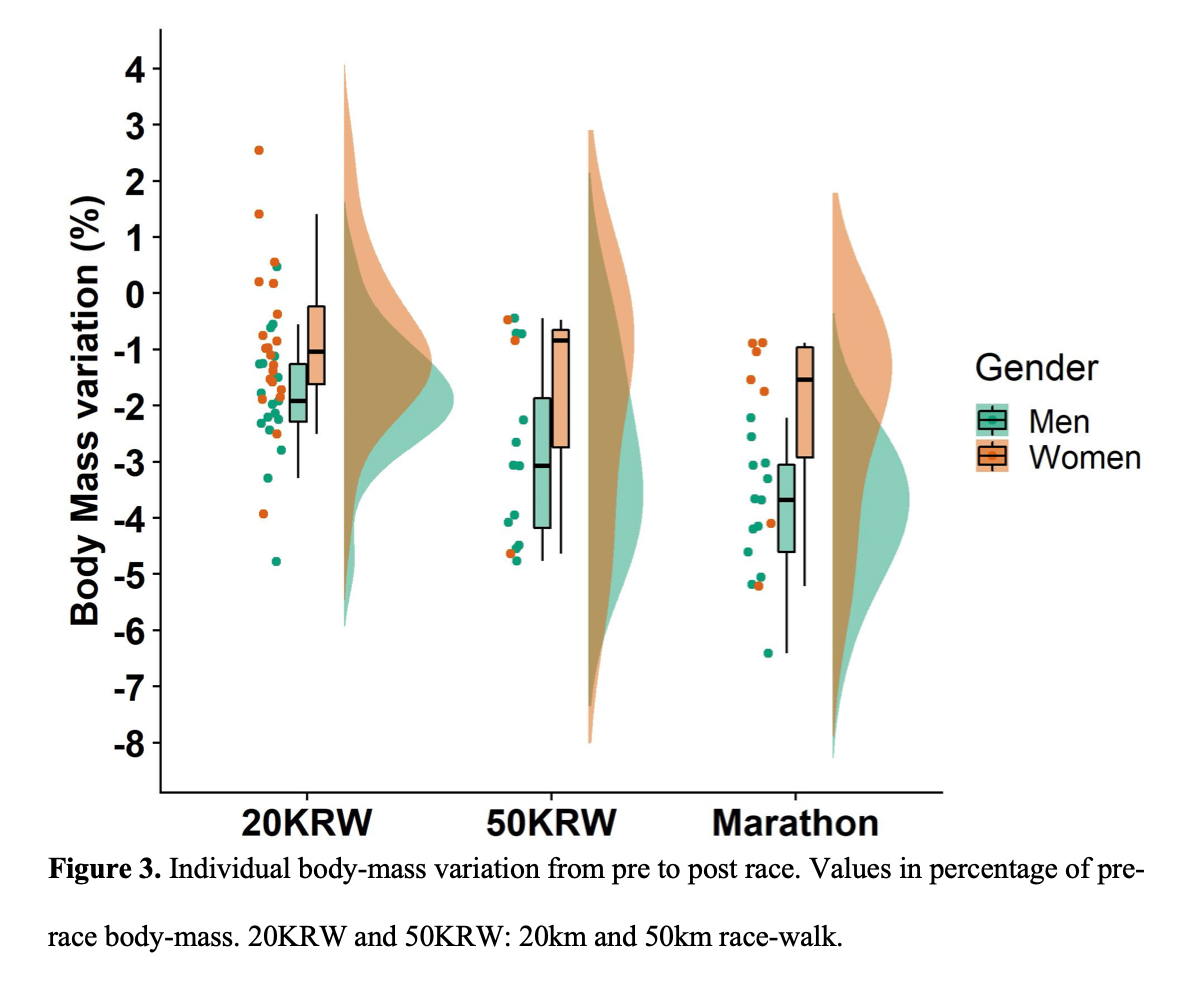
However, DNF had a higher pre-race skin temperature (33.8°C±0.9°C vs 32.6°C±1.4°C), while within finishers a lower pre-race skin temperature was moderately associated with faster race completion (r=0.32). Overall, skin temperature, its rate of decrease and the core-to-skin temperature gradient (but not core temperature per se, 39.6±0.6°C) were related to DNF or an in-race medical event.
The number of athletes who acclimated for 5–30 days before the world championship is increasing as compared to previous world championships, but still represent “only” 63% of the athletes. The athletes who acclimated were better ranked, less likely to DNF or have an in-race medical event, alongside having lower thermal strain than the other athletes (Figure 4).
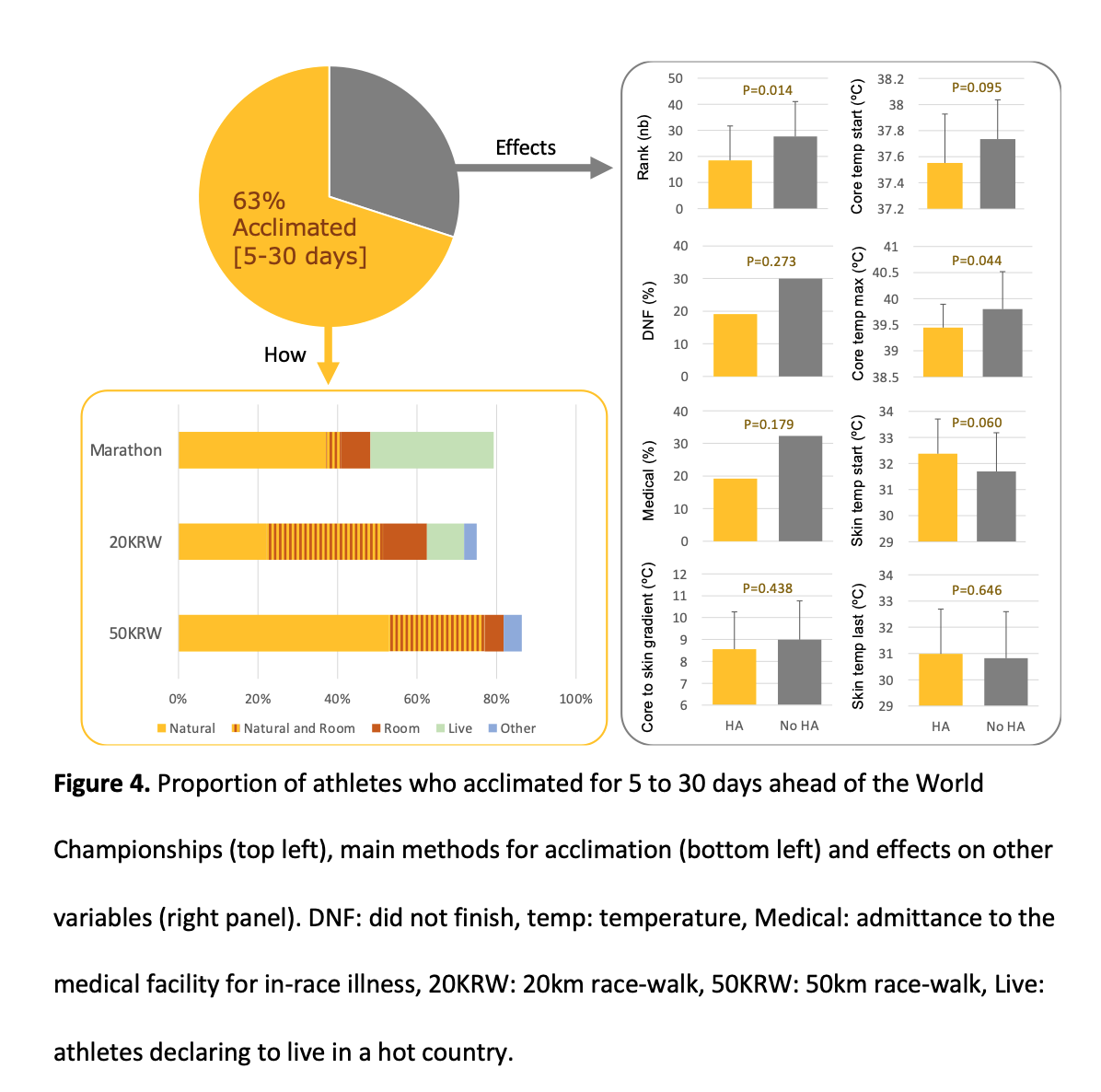
Lastly, 9% of surveyed athletes had diarrhoea in the 10 days preceding the World Athletics Championships, increasing their likelihood of DNF (from 20% to 43%) and an in-race medical event (from 17% to 71%, Figure 5).
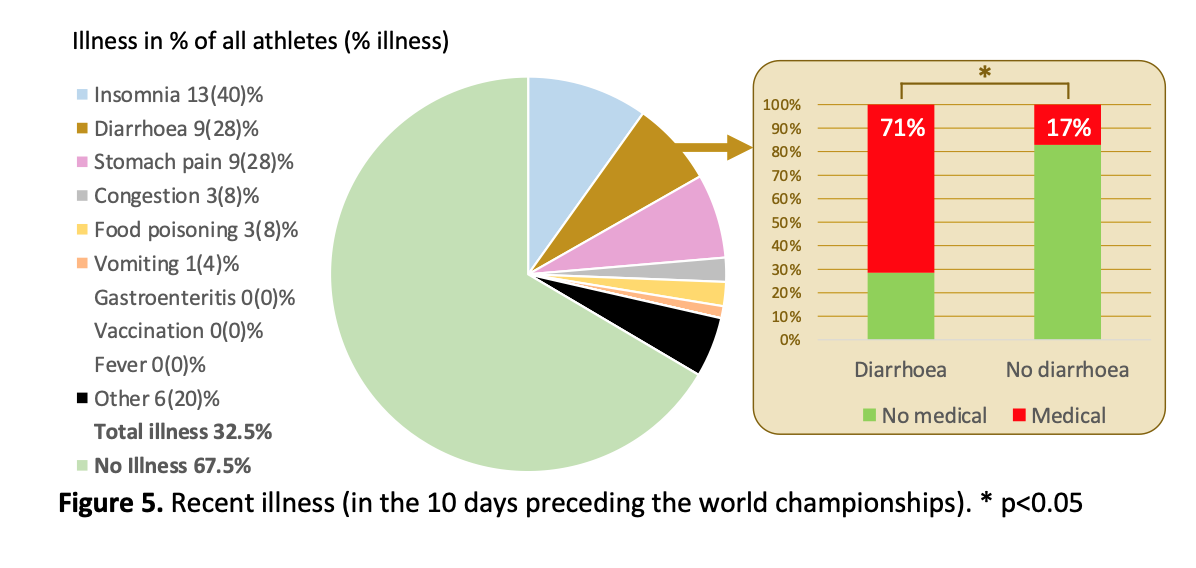
What are the key take-home points?
Event organisers should consider the logistical facilities required (ie, freezers) to facilitate ice vest usage at warm-up, as this is a common choice by athletes.
Real-time measuring technologies under development should integrate skin temperature monitoring along core temperature measurements. The skin temperature should be properly protected during warm-up.
Health status during the 10 days preceding a competition in the heat should be closely monitored, with a particular attention to diarrhoea and/or GI tract issues.
Heat acclimation works! Educational materials on heat acclimation should be promoted to assist athlete and coaches in preparation for competitions in hot and humid environments.
Author and Affiliation:
Prof. Sebastien Racinais (PhD)
Head of Research
Aspetar
References
1 Racinais S, Ihsan M, Taylor L, et al. Hydration and cooling in elite athletes: relationship with performance, body mass loss and body temperatures during the Doha 2019 IAAF World Athletics Championships. British Journal of Sports Medicine Published Online First: 12 February 2021. doi:10.1136/bjsports-2020-103613
2 Racinais S, Havenith G, Aylwin PE, et al. Association between thermal responses, medical events, performance, heat acclimation and health status in male and female elite athletes during the 2019 Doha World Athletics Championships. British Journal of Sports Medicine 2022;:1–11. doi:10.1136/bjsports-2021-104569
3 Beis LY, Wright-Whyte M, Fudge B, et al. Drinking behaviors of elite male runners during marathon competition. Clin J Sport Med 2012;22:254–61. doi:10.1097/JSM.0b013e31824a55d7
4 Racinais S, Moussay S, Nichols D, et al. Core temperature up to 41.5ºC during the UCI Road Cycling World Championships in the heat. British Journal of Sports Medicine 2019;53:426–9. doi:10.1136/bjsports-2018-099881
5 Hosokawa Y, Racinais S, Akama T, et al. Prehospital management of exertional heat stroke at sports competitions: International Olympic Committee Adverse Weather Impact Expert Working Group for the Olympic Games Tokyo 2020. British Journal of Sports Medicine Published Online First: 22 April 2021. doi:10.1136/bjsports-2020-103854
6 Byrne C, Lee JKW, Chew SAN, et al. Continuous thermoregulatory responses to mass-participation distance running in heat. Med Sci Sports Exerc 2006;38:803–10. doi:10.1249/01.mss.0000218134.74238.6a
7 Racinais S, Alhammoud M, Nasir N, et al. Epidemiology and risk factors for heat illness: 11 years of Heat Stress Monitoring Programme data from the FIVB Beach Volleyball World Tour. British Journal of Sports Medicine 2021;55:831–5. doi:10.1136/bjsports-2020-103048
8 Racinais S, Alonso JM, Coutts AJ, et al. Consensus recommendations on training and competing in the heat. British Journal of Sports Medicine 2015;49:1164–73. doi:10.1136/bjsports-2015-094915
9 Aylwin PE, Racinais S, Bermon S, et al. The use of infrared thermography for the dynamic measurement of skin temperature of moving athletes during competition; methodological issues. Physiol Meas 2021;42:08.4004. doi:10.1088/1361-6579/ac1872